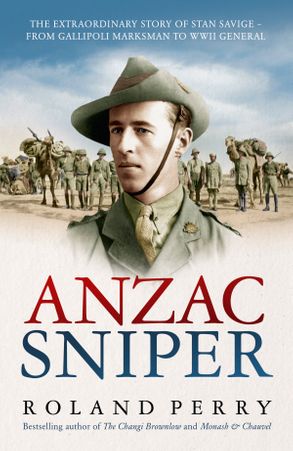This is an intriguing biography of a most unassuming, competent and compassionate self-made man whose contributions have lived on as a heritage for which Australians can be most grateful.

Paperback 400pp RRP $32.99
His interest in scouting and cadets at a young age saw Savige develop technical and leadership skills that played a vital role in his many later successes.
Enlisting in May 1915, he landed on Gallipoli September 1915 as a sergeant with 24th Battalion An extremely good shot with both rifle and pistol he was quickly tasked as a sniper on Sniper’s Ridge where he was credited with over 30 confirmed kills in a few short days. By November he was a second lieutenant company commander.
On the Western Front Savige saw action with 1 and 2 Anzac Corps at Pozières, Mouquet Farm, Bullecourt, Broodseinde, Hamel and Passchendaele. He was affected by phosgene gas at Pozières and Mouquet Farm – and lived with diminished lung capacity thereafter. Mentioned in dispatches three times, he was awarded the Military Cross for his actions at the Hindenberg Line on 3 May 1917.
Savige did not see out the last 100 days on the Western Front. In January 1918, as a captain, he became a member of Dunsterforce under command of Major General Dunsterville in Persia. A specially selected group of 500, the force conducted actions similar to those of our Special Forces today. Savige led over 70, 000 Armenians and Assyrian refugees to freedom as he protected them from Kurdish and Turkish raiders. This saw him awarded a DSO.
Post-war saw him become the Chair of the Central War Gratuity Board – processing three-quarters of a million applications between 1918 and 1945. In 1923 he became sole selling agent for RS&S Woollen and Worsted Mill Cooperative in Geelong, and that year founded Legacy to take care of the sons of deceased servicemen. He also became Police Commissioner Thomas Blamey’s invaluable assistant during the October 1923 police strike and subsequent riots. Promoted to major in 1924 (commanding 37th Battalion), and lieutenant colonel in 1926, he became the Commanding Officer of his former battalion (24th Bn) in 1928. Meanwhile, not happy about the daughters of deceased service personnel missing out, he ensured Legacy became accessible to girls in 1927. Savige entered the Victorian State Parliament in 1930 and commanded 10th Brigade as a colonel in 1935 and as a brigadier in 1938.
World War II saw Savige leading 17th Brigade at Bardia, Tobruk and Derna (for which he was awarded the Commander of the Order of the British Empire (CBE)). After the withdrawal from Greece in April 1941, he returned to Australia, was promoted to major general in January 1942 and as Commander 3rd Division, given responsibility for recruiting for the Militia. The bombing of Darwin in February saw rapid changes being made.
Savige had 30,000 untrained recruits which would form two divisions to defend Australia. (New Guinea being part of Australia’s territory, members of the Militia were able to serve there.) In October 1942 he was appointed to administer command of II Australian Corps (retaining command of 3rd Division). His 3rd Division took the battle to the Japanese in the Wau-Salamaua area – consequently he was awarded the Companion of Order of the Bath. His final roll of the dice was as a lieutenant general commanding II Corps on Bougainville.
Post-war saw him continue his work with Legacy and RS&S Woollen. Stan Savige died in May 1954, pre-deceased by his wife two months earlier.
Few Australian military men have fought and led men at all levels as Savige did. His story has been told in generous prose that includes all the back-stabbing and intriguing military politics of the times. Three simple maps show readers, with the exception of Gallipoli, the location of the campaigns Savige fought in during both World Wars. A generous selection of high-quality photographs of family and military personnel have been included as an insert. Ten pages of Endnotes and a comprehensive Bibliography and Index round out this impressive work that goes a long way towards bringing to the fore one of Australia’s lesser known leaders in both war and peace.
Reviewed for RUSI by Neville Taylor, August 2019
Contact Royal United Services Institute about this article.






